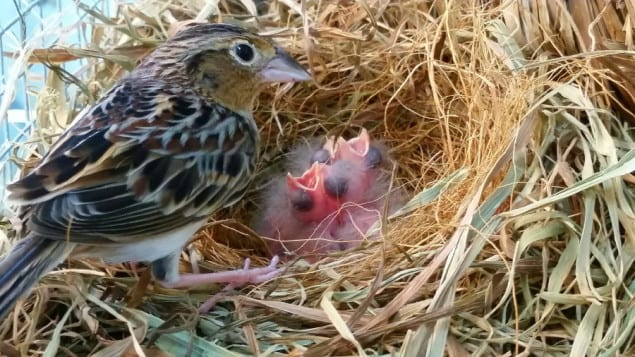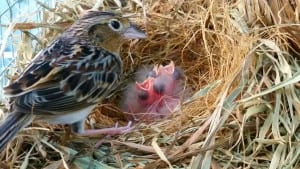
The first captive-bred Florida Grasshopper Sparrow hatched this week under the care of researchers with FIU’s Tropical Conservation Institute.
One of the world’s most endangered birds, the Florida Grasshopper Sparrow exclusively resides in Central Florida. At last count, less than 100 males remain in the wild and the number of elusive females is unknown. Last year, seven sparrows were put in the care of TCI researchers — the first to ever be reared in a captive setting. TCI is a collaboration with the Rare Species Conservatory Foundation in Loxahatchee, Fla., where the sparrows are currently residing.
“The first captive breeding of the Florida Grasshopper Sparrow sparks hope for this critically endangered endemic from Central Florida’s prairie,” said TCI Director Paul Reillo, who is also the founding president of Rare Species. “With wild populations declining, our first priority is to prevent extinction. This first captive clutch is exciting and humbling, providing an intimate window into the sparrow’s secretive world. It also reminds us that recovery will take many years, concerted, coordinated effort, and substantial funding. “
In total, four chicks hatched this week, with the first making its debut at 7:30 a.m., May 9.

The chicks were a pleasant surprise for Reillo, who expected several false starts before successful breeding. Between three males and four females, a successful nesting requires a pair of unrelated birds that get along well enough to mate and successfully hatch chicks. The odds were long. But two birds started showing interest in each other in early spring and the female laid her first egg April 26.
The chicks are estimated to weigh less than 2 grams. Currently, the mother is taking care of the young, and TCI researchers and Rare Species staff are working around the clock to ensure the mother and chicks are fed and properly pampered. The chicks are expected to fledge from their nest next week.
While the chicks give scientists a reason to celebrate, Reillo says much uncertainty remains. After all, four chicks is a long way from recovery for a species on the brink of extinction. Conservationists agonized for years over how to stop the plunge in the tiny songbird’s population, occurring for reasons still unknown. In a desperate attempt to save the species, officials from U.S. Fish and Wildlife Service gave approval last year to take the seven into captivity. Currently, the now-11 residing in Loxahatchee are the only ones living under the care of researchers in captivity.
Aside from the biological challenges of breeding such a delicate species in captivity, another challenge is funding. Researchers are relying on a series of grants to cover the nearly $120,000 in annual costs to sustain the captive breeding program for the birds. TCI also has received a donation of cooling fans from Dyson and feeding supplies from Timberline Fisheries. But as Reillo points out, the financial cost is minor when compared to the cost of losing an entire species to extinction.






